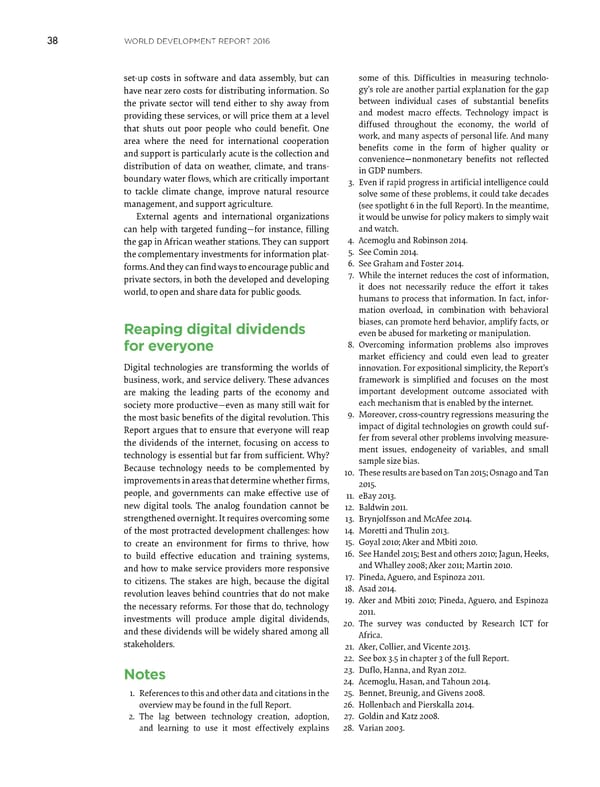WORLD DEVELOPMENT REPORT 2016 38 set-up costs in software and data assembly, but can some of this. Difficulties in measuring technolo- have near zero costs for distributing information. So gy’s role are another partial explanation for the gap the private sector will tend either to shy away from between individual cases of substantial benefits providing these services, or will price them at a level and modest macro effects. Technology impact is that shuts out poor people who could benefit. One diffused throughout the economy, the world of area where the need for international cooperation work, and many aspects of personal life. And many and support is particularly acute is the collection and benefits come in the form of higher quality or distribution of data on weather, climate, and trans- convenience—nonmonetary benefits not reflected boundary water flows, which are critically important in GDP numbers. 3. Even if rapid progress in artificial intelligence could to tackle climate change, improve natural resource solve some of these problems, it could take decades management, and support agriculture. (see spotlight 6 in the full Report). In the meantime, External agents and international organizations it would be unwise for policy makers to simply wait can help with targeted funding—for instance, filling and watch. the gap in African weather stations. They can support 4. Acemoglu and Robinson 2014. the complementary investments for information plat- 5. See Comin 2014. forms. And they can find ways to encourage public and 6. See Graham and Foster 2014. private sectors, in both the developed and developing 7. While the internet reduces the cost of information, world, to open and share data for public goods. it does not necessarily reduce the effort it takes humans to process that information. In fact, infor- mation overload, in combination with behavioral Reaping digital dividends biases, can promote herd behavior, amplify facts, or even be abused for marketing or manipulation. for everyone 8. Overcoming information problems also improves market efficiency and could even lead to greater Digital technologies are transforming the worlds of innovation. For expositional simplicity, the Report’s business, work, and service delivery. These advances framework is simplified and focuses on the most are making the leading parts of the economy and important development outcome associated with society more productive—even as many still wait for each mechanism that is enabled by the internet. the most basic benefits of the digital revolution. This 9. Moreover, cross-country regressions measuring the Report argues that to ensure that everyone will reap impact of digital technologies on growth could suf- - the dividends of the internet, focusing on access to fer from several other problems involving measure technology is essential but far from sufficient. Why? ment issues, endogeneity of variables, and small Because technology needs to be complemented by sample size bias. improvements in areas that determine whether firms, 10. These results are based on Tan 2015; Osnago and Tan 2015. people, and governments can make effective use of 11. eBay 2013. new digital tools. The analog foundation cannot be 12. Baldwin 2011. strengthened overnight. It requires overcoming some 13. Brynjolfsson and McAfee 2014. of the most protracted development challenges: how 14. Moretti and Thulin 2013. to create an environment for firms to thrive, how 15. Goyal 2010; Aker and Mbiti 2010. to build effective education and training systems, 16. See Handel 2015; Best and others 2010; Jagun, Heeks, and how to make service providers more responsive and Whalley 2008; Aker 2011; Martin 2010. to citizens. The stakes are high, because the digital 17. Pineda, Aguero, and Espinoza 2011. revolution leaves behind countries that do not make 18. Asad 2014. the necessary reforms. For those that do, technology 19. Aker and Mbiti 2010; Pineda, Aguero, and Espinoza investments will produce ample digital dividends, 2011. and these dividends will be widely shared among all 20. The survey was conducted by Research ICT for Africa. stakeholders. 21. Aker, Collier, and Vicente 2013. 22. See box 3.5 in chapter 3 of the full Report. Notes 23. Duflo, Hanna, and Ryan 2012. 24. Acemoglu, Hasan, and Tahoun 2014. 1. References to this and other data and citations in the 25. Bennet, Breunig, and Givens 2008. overview may be found in the full Report. 26. Hollenbach and Pierskalla 2014. 2. The lag between technology creation, adoption, 27. Goldin and Katz 2008. and learning to use it most effectively explains 28. Varian 2003.
 World Development Report 2016 Page 55 Page 57
World Development Report 2016 Page 55 Page 57